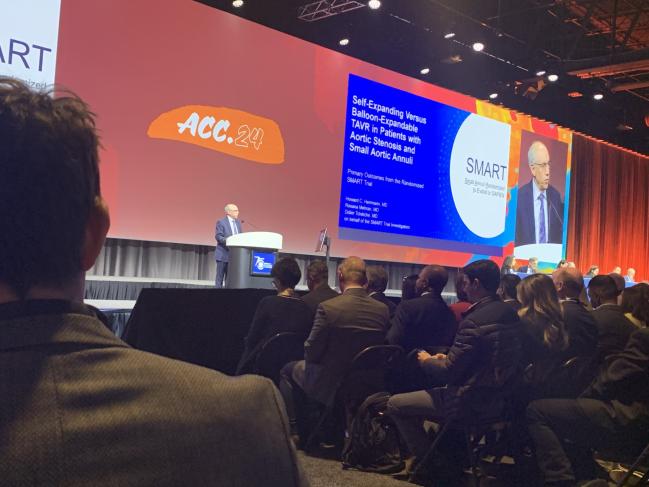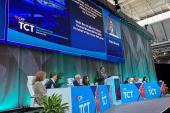SMART: Small Aortic Annuli May Fare Best With Self-Expandable Valve
(UPDATED) Whether the bioprosthetic valve dysfunction difference translates to long-term advantage remains to be seen, says Suzanne Baron.

ATLANTA, GA—Compared with a balloon-expandable valve, TAVI with a self-expanding supra-annular valve results in similar rates of clinical outcomes at 1 year but offers lower rates of bioprosthetic dysfunction in patients with symptomatic severe aortic stenosis and a small aortic annulus, the SMART trial concludes.
The trial population was overwhelmingly female, at nearly 90%.
Across multiple definitions of bioprosthetic-valve dysfunction, including VARC-3 criteria, “the results in all cases supported our conclusions with respect to the second coprimary endpoint—that is, that significantly less bioprosthetic-valve dysfunction occurred with the self-expanding valve than with the balloon-expandable valve,” write Howard C. Herrmann, MD, (Perelman School of Medicine at the University of Pennsylvania, Philadelphia), and colleagues in a paper published today in the New England Journal of Medicine to coincide with the study’s presentation here at the American College of Cardiology 2024 Scientific Session.
The composite of death, disabling stroke, or HF rehospitalization, the other co-primary endpoint, occurred in 9.4% of patients who received the self-expanding Evolut PRO/PRO+/FX (Medtronic) compared with 10.6% who received the balloon-expandable SAPIEN 3/3 Ultra (Edwards Lifesciences; P < 0.001 for noninferiority).
Commenting for TCTMD, Suzanne J. Baron, MD (Massachusetts General Hospital, Boston, MA), said the largely female cohort is cause for excitement given women’s historic underrepresentation in device-based trials.
“Obviously, much effort was put in by the investigators to make that happen,” she said. “The fact that we did see a difference in hemodynamic outcomes at 1 year, though, is frankly not surprising because we know that the supra-annular platform is going to give lower gradients and higher [effective orifice area; EOA]. We didn’t see that translate to clinical outcomes. For me, the real question is going to be will we see that difference in the future and if so, when and what is it going to mean for this patient population?”
This will certainly be something that I will take into consideration when I see patients, and particularly women, with small annuli. Suzanne J. Baron
In a press conference following the presentation, Herrmann said follow-up in SMART is planned through 5 years and he anticipates that the hemodynamic differences will translate to a long-term difference between the groups.
“We believe that we will see the effects on clinical outcomes sooner than 5 years, probably between 2 and 4 years,” he stated.
While some data do suggest that higher gradients, smaller EOA, and severe prosthesis-patient mismatch lead to poor outcomes, Baron said that only time will tell. For now the data from SMART are additional pieces of information for operators to consider amid a range of other patient-specific factors when deciding between device platforms.
“These patients are so complex. There's not only one thing that enters into your decision-making when you're doing your preprocedural planning,” she noted. “This will certainly be something that I will take into consideration when I see patients, and particularly women, with small annuli. It factors in; but from my standpoint, it's just one factor. It won't be the only factor.”
More Than 30% Difference in Valve Dysfunction Rates
SMART enrolled 716 low- to intermediate-risk patients (mean age 80 years; 87% women) from 83 sites in 13 countries. The mean aortic annulus area was 380.9 mm2 in those randomized to the self-expanding device and 382.8 mm2 in those randomized to the balloon-expanding device.
Procedure times were about 10 minutes shorter in the balloon-expandable group, while catheter times were about 4 minutes shorter and contrast volume use was lower.
Device success at 30 days by the VARC-2 definition was higher in the self-expanding group at 85.2% versus 59.2% (P < 0.001) and by the VARC-3 definition at 94.5% versus 86.6% (P < 0.001).
With a difference of 32.2%, bioprosthetic valve dysfunction rates through 12 months for the entire cohort were markedly lower with the self-expanding versus balloon-expanding device (P < 0.001 for superiority). Sensitivity analyses according to treatment group and analysis population for each coprimary endpoint were not different from those of the primary analysis.
Additionally, a secondary endpoint analysis of only women found a rate of bioprosthetic-valve dysfunction through 12 months of 10.2% for the self-expanding valve compared with 43.3% for the balloon-expandable valve (P < 0.001).
At 12 months, the mean gradient was 7.7 mm Hg in the self-expanding group and 15.7 mm Hg in the balloon-expandable group. Similarly, the mean EOA was larger in the self-expanding group at 1.99 cm2 compared with 1.50 cm2, respectively. The rate of hemodynamic structural valve dysfunction was 3.5% in the self-expanding valve group and 32.8% in the balloon-expandable valve group (P < 0.001 for all comparisons).
Notably, while SMART used VARC-3 criteria for device success at 30 days, it used VARC-2 criteria to define clinical valve thrombosis, said Rebecca Hahn, MD (NewYork-Presbyterian/Columbia University Irving Medical Center, New York, NY), who spoke during a deep-dive session on SMART. But VARC-3, insisted Hahn, is “where we need to be” in determining thrombosis rates, because it takes the “vagueness” out of the definition. Under VARC-2, clinical valve thrombus could be “any thrombus attached to or near an implanted valve that includes part of the blood flow path. . . . . It is a little bit disturbing that we have VARC-2 instead of VARC-3.”
This is not dysfunction. Rebecca Hahn
Hahn, who was a co-author on the 2021 VARC-3 document, said the newer definitions are also clearer on the issue of hemodynamic structural dysfunction.
“You must have morphologic change or stage 1 in order to consider hemodynamic changes as dysfunction. So, this is not dysfunction, the valve was just put in,” she said, noting that when balloon-expandable valves are first placed, high mean gradients are commonplace and to be expected. “These are normally functioning valves with a high gradient.” What’s becoming increasingly clear, is that low gradients, but not high gradients, are the ones associated with worse outcomes, Hahn added.
Furthermore, she said, it is well known that women “tend to have higher peak and mean gradients at baseline for the same valve area as a man,” and higher left ventricular ejection fraction. The SMART data did not report baseline peak/mean gradients, delta mean gradients, or hemodynamic valve deterioration, all of which might be helpful in honing predictions of events down the line.
“I really, really welcome an analysis and full disclosure of all the echocardiographic parameters in order for us to understand if the high gradients are in part related to the high ejection fraction,” Hahn said.
Quality of Life
Herrmann and colleagues also looked at quality of life (QoL) via the Kansas City Cardiomyopathy Questionnaire (KCCQ) ordinal outcome according to VARC-3 criteria. In his presentation, he noted that the overall summary score increased by about 20 points in both groups. However, for the VARC-3 KCCQ ordinal outcome score, which divides the total score into categories, there was greater improvement in patients treated with the self-expanding valve, driven by a nearly 10% increase in the category of substantial improvement.
Baron added that it will be necessary to dive deeper into the QoL findings to understand how and why hemodynamics influence those outcomes, noting that it could potentially become a talking point for shared decision-making given the importance that patients place on many aspects of quality over quantity of life.
Speaking with TCTMD, Wayne Batchelor, MD (Inova Heart and Vascular Institute, Falls Church, VA), a panelist at the press conference, said SMART has kicked off an important discussion that likely will continue for years.
“The whole story is really going to be does this translate into differences in heart failure hospitalizations and longevity of the valves,” he said. “That's why that 5-year data is going to be so extremely critical. I think [SMART] has rocked the boat quite a bit. It's going to generate a lot of controversy, and there are going to be people who are going to really focus on the hemodynamic differences, and there will be naysayers who will say that it's not the whole story. But, no longer can we really argue that if you have a small annulus and you put in a balloon-expandable that you can expect the same kind of hemodynamic response as to a supra-annular valve. That discussion, I think, is no longer relevant.”
In SMART, moderate or severe prosthesis-patient mismatch was approximately three times higher in the balloon-expandable group compared with the self-expanding group (P < 0.001).
Batchelor noted that in the surgical literature, it’s already well-accepted that patient-prosthesis mismatch contributes to adverse outcomes.
“It seems to carry validity that it increases the risk later on in terms of heart failure risk and other adverse events. We can't assume, but I would be surprised if at some degree that doesn't hold true for TAVR valves,” he added. “The question is, within the valve frames that we're comparing, how big a difference is that going to be and how clinically significant?”
L.A. McKeown is a Senior Medical Journalist for TCTMD, the Section Editor of CV Team Forum, and Senior Medical…
Read Full BioSources
Herrmann HC, Mehran R, Blackman DJ, et al. Self-expanding or balloon-expandable TAVR in patients with a small aortic annulus. N Engl J Med. 2023;Epub ahead of print.
Disclosures
- The study was funded by Medtronic.
- Herrmann reports institutional grants/research support from Abbott Vascular, Boston Scientific, Edwards Lifesciences, Medtronic, Highlife Med, Innovalve, Shockwave; and consulting fees/honoraria from Edwards Lifesciences, Johnson & Johnson, Medtronic, Prolifagen, Truffle Capital, and Wells Fargo.
- Hahn reports having institutional consulting contracts with Abbott Vascular, Boston Scientific, Edwards Lifesciences, Medtronic, and Novartis, and serving on the speaker’s bureau for Abbott Structural, Baylis Medical, Edwards Lifesciences, and Phillips Healthcare.





Comments